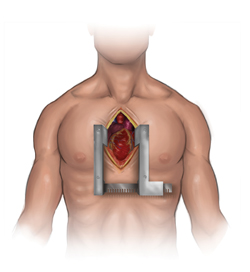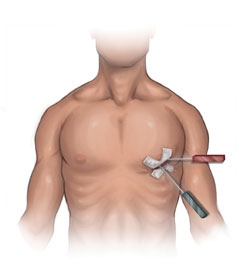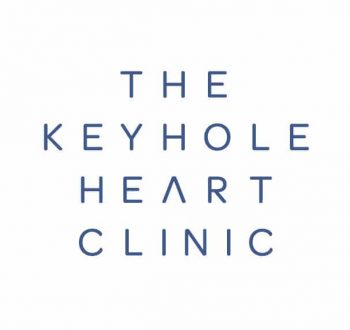Keyhole Coronary Artery Bypass
Keyhole (Minimally Invasive) Coronary Bypass Surgery
This procedure, also known as Minimally Invasive Direct Coronary Artery Revascularisation (MIDCAB), is performed via a left minithoracotomy incision on the beating heart. The procedure is an excellent therapy when performed by surgeons with experience in both keyhole surgery and beating heart surgery. It is most commonly used in patients with isolated disease of the Left Anterior Descending Artery (LAD) a very important branch of the left coronary artery. It is also possible to graft more than one vessel using this technique in highly selected patients.
Here is a diagram to simplify the differences between traditional and minimally invasive approaches:
Traditional Breastbone Division

- Broken bone
- Heals in 3 months
- No heavy lifting for 12 weeks
- Small risk of bone infection
- Mild to moderate pain
- Cosmetically less appealing
Keyhole Approach

- No broken bone
- Heals within 7 days
- Resume activity within days
- No bone infection risk
- Minimal pain
- Superior cosmetic appeal
Hybrid keyhole coronary artery surgery
Although multiple bypass grafts can be performed via keyhole openings in carefully selected patients, the mainstay of keyhole coronary bypass surgery has been restricted to those patients with single vessel disease involving a major artery on the front of the heart called the LAD (left anterior descending artery). In these patients we can perform a procedure called Minimally Invasive Direct Coronary Artery Bypass Surgery (MIDCAB). This involves surgery on the beating heart via a small opening placed between the ribs on the front of the left chest. There is no doubt that surgical revascularisation of this particular vessel offers a much better long-term clinical outcome compared to stenting of the artery, and the recovery from MIDCAB in experienced hands offers significantly reduced hospital stay, with healing within days rather than weeks when compared with traditional surgery through the breastbone cut.
To widen the benefits of keyhole revascularisation, a therapy called Hybrid coronary artery bypass grafting can be offered to some patients. This treatment involves two procedures performed either on separate occasions or at the same time, which is designed to offer the superior benefits of revascularisation of the LAD via the MIDCAB opening, followed by treatment of any remaining narrowed arteries using stents, the ultimate aim being to avoid breastbone division.
Until recently, little was known about the immediate and long-term outcomes of this approach. In a recent article to be published in The Journal of the American College of Surgeons, Hybrid Coronary Revascularisation was compared with traditional multi-vessel bypass grafting via breastbone division.
Hybrid coronary revascularisation was associated with:
- Reduced rates of in-hospital major morbidity
- Reduced blood transfusion use
- Reduced chest tube drainage (blood loss)
- Reduced postoperative length of stay
Hybrid therapies can be used to treat coronary disease and valve disease through keyhole techniques. Contact us to learn more about these treatments.
In some patients with multi-vessel coronary disease, the entire procedure can be performed by keyhole heart surgery. This can only be performed in selected patients by highly experienced keyhole heart surgery teams. Call us if you wish to know more.
Coronary Stent Insertion
This is a very effective therapy for isolated disease of the coronary arteries. A catheter is placed into the coronary artery using coronary angiography (click for video), and a small balloon can be used to inflate the diseased area . This area can then be held open with a coronary stent (click for video). The advantage of this approach is that it can be performed as a day case, and requires no surgery. The catheter is inserted into the body via a wrist or groin vessel. The disadvantage of this approach is that the stent can block over time leading to recurrence of symptoms. Stents are used very effectively in emergency situations to stop a heart attack from creating irreversible cardiac muscle injury. This is why you must always call for an ambulance if you think you are having a heart attack.
Surgery for certain types of disease is more likely to offer you better long-term results. This is particularly true for multiple lesions, and for high grade proximal lesions. Your cardiologist and surgeon will be able to make the correct judgement for you regarding the suitability of stenting or surgery.
If you are referred to The keyhole London Heart Clinic, your case will be discussed by a multidisciplinary team to ensure the pros and cons of these different strategies can be presented to you so that you can decide which treatment is best for you. In the short and long term. Alternatively, if you are not sure which decision to make, we can ensure that the best evidence will be used in making the decision for you.
